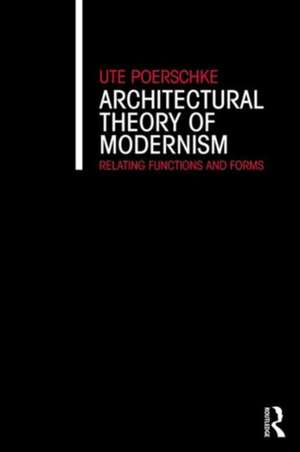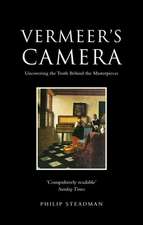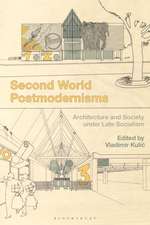Architectural Theory of Modernism: Relating Functions and Forms
Autor Ute Poerschkeen Limba Engleză Paperback – 27 apr 2016
| Toate formatele și edițiile | Preț | Express |
|---|---|---|
| Paperback (1) | 323.48 lei 43-57 zile | |
| Taylor & Francis – 27 apr 2016 | 323.48 lei 43-57 zile | |
| Hardback (1) | 989.77 lei 43-57 zile | |
| Taylor & Francis – 6 ian 2016 | 989.77 lei 43-57 zile |
Preț: 323.48 lei
Preț vechi: 416.55 lei
-22% Nou
61.90€ • 64.79$ • 51.52£
Carte tipărită la comandă
Livrare economică 31 martie-14 aprilie
Specificații
ISBN-10: 1138642487
Pagini: 250
Ilustrații: 26
Dimensiuni: 156 x 234 x 18 mm
Greutate: 0.42 kg
Ediția:1
Editura: Taylor & Francis
Colecția Routledge
Locul publicării:Oxford, United Kingdom
Public țintă
Postgraduate and UndergraduateCuprins
1.What are Architectural Functions 2. Function and Representation 3. Form and Function in the Structured Whole 4. Concepts of Function in High Modernism 5. Functionalism and its Criticism 6. Functions and Forms in Architecture of the Information Society Bibliography Image Sources Index
Notă biografică
Ute Poerschke, PhD, BDA, is an associate professor of architecture at the Pennsylvania State University, USA. She is a principal of the architecture firm Friedrich Poerschke Zwink Architekten in Munich, Germany, and co-editor of Cloud-Cuckoo-Land: International Journal of Architectural Theory.
Descriere
Architectural Theory of Modernism presents an overview of the discourse on function-form concepts from the beginnings, in the eighteenth century, to its peak in High Modernism. Functionalist thinking and its postmodern criticism during the second half of the twentieth century is explored, as well as today's functionalism in the context of systems theory, sustainability, digital design, and the information society.
The book covers, among others, the theories of Carlo Lodoli, Gottfried Semper, Eugene-Emmanuel Viollet-le-Duc, Louis Sullivan, Frank Lloyd Wright, Hannes Meyer, Adolf Behne, CIAM, Jane Jacobs, Robert Venturi and Denise Scott Brown, Charles Jencks, William Mitchell, and Manuel Castells."







